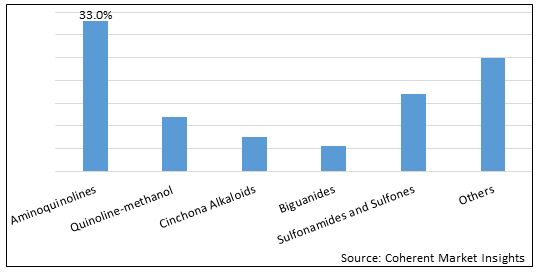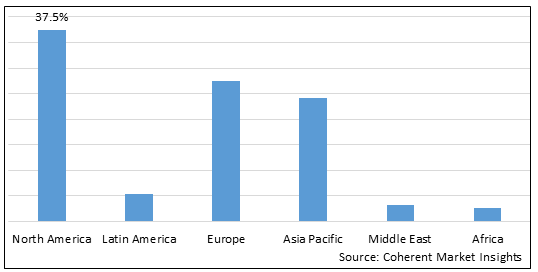The global anti-malarial drugs market is estimated to be valued at US$ 989.7 million in 2023 and is expected to exhibit a CAGR of 4.5% during the forecast period (2023-2030).
Analysts’ Views on Global Anti-malarial Drugs Market:
To enable a platform that is rapid, efficient sample processing and the market is being driven primarily by the rising prevalence of malaria and the increasing of research and development along with the partnership or acquisitions in order to develop a novel treatment approach are expected to drive the global anti-malarial drugs market for the forecast period. For instance, according to the latest World Malaria Report, released in December 2021, there were an estimated 241 million cases of malaria and 627,000 resulting deaths worldwide in 2020. This represents about 14 million more cases in 2020 compared to 2019, and 69,000 more deaths. Approximately two-thirds of these additional deaths (47,000) were linked to disruptions in the provision of malaria prevention, diagnosis and treatment interventions caused by the COVID-19 pandemic.
Figure 1. Global Anti-malarial Drugs Market Share (%), by Drug Class, 2023

To learn more about this report, request a free sample copy
Global Anti-malarial Drugs Market – Driver
Increasing regional government funds and increasing prevalence of malaria
Increasing incidence of malaria is expected to boost growth of the global anti-malarial drugs market over the forecast period. Increasing regional government funds for the development and research can also propel the growth over the forecast period. For instance, on April 24 2023, the U.S. and Mali worked together to provide malaria services that saved lives and supported communities. Investments in malaria prevention and treatment tools, along with the training and equipping of health workers, advanced Mali’s progress against the disease while strengthening the country’s health system. The U.S. President’s Malaria Initiative (PMI) has partnered with Mali to fight malaria since, contributing US$ 364 million to date and US$ 25 million in FY 2022. PMI’s Annual Report, released, showcases how PMI is working with partner countries, such as Mali to help make sure all those at risk from malaria are protected and to support local communities to shape and lead activities to end malaria faster.
Figure 2. Global Anti-malarial Drugs Market Value (US$ Million), by Region, 2023

To learn more about this report, request a free sample copy
Global Anti-malarial Drugs Market- Regional Analysis
Among regions, Asia pacific is estimated to hold 24.1% of the market share in 2023. The Asia Pacific anti-malarial drug market is expected to witness significant growth in the coming years, driven by factors such as the increasing prevalence of malaria, and the rising demand for research and development for the malarial treatment. Thus, the rise in anti-malarial drugs market growth over the forecast period.
Global Anti-malarial Drugs Market – Impact of Coronavirus (COVID-19) Pandemic
Since the COVID-19 virus outbreak in December 2019, the disease spread to over 100 countries across the globe, and the World Health Organization declared it a public health emergency on January 30, 2020.
COVID-19 affected the economy in three main ways: by directly affecting the production and demand of drugs, by creating disruptions in distribution channels, and through its financial impact on firms and financial markets. Due to nationwide lockdowns, several countries such as China, India, Saudi Arabia, the U.A.E., Egypt, and others are facing problems with the transportation of drugs from one place to another.
However, the COVID-19 pandemic had a positive impact on the global anti-malarial drugs market. COVID-19 treatment boosted the anti-malarial drugs as the COVID-19 treatment required the use of chloroquine and hydroxychloroquine. For instance, in July 2020, according to an article published by Elsevier in the journal of Medicina Clínica, an article discusses the use of antimalarial drugs in the treatment of COVID-19. The article explains how chloroquine and hydroxychloroquine may be effective in treating the virus, based on previous research and clinical trials. The article also discusses the potential benefits and risks of using these drugs, and how they may help reduce the duration of the disease and hospitalization time.
Global Anti-malarial Drugs Market Segmentation:
The global anti-malarial drugs market report is segmented into by Drug Class, by Route of Administration, By Distribution Channel, and Region.
By Drug Class, the market is segmented into Aminoquinolines, Quinoline-methanol (4-quinolinemethanols), Cinchona Alkaloids, Biguanides, Sulfonamides and Sulfones, and Others. Out of which, the Aminoquinolines segment is expected to dominate the global anti-malarial drugs market during the forecast period and this is due to the increasing its use for the treatment of antiviral, antimalarial as well as COVID-19, as the key players are focusing on growth strategies such as research and development and others like acquisitions, partnerships, which is expected to propel the market growth.
Based on Route of Administration, the global anti-malarial drugs market is segmented into oral and injectable. Out of which, injectable is expected to dominate the market over the forecast period and this is attributed to the increasing prevalence of malaria along with the rapid onset of action of injectable.
Based on Distribution Channel, the global anti-malarial drugs market is segmented into Hospital Pharmacies, Retail Pharmacies, and Online Pharmacies. The Hospital pharmacies segment is expected to dominate the market over the forecast period and this is attributed to the malarial treatment required prescription drugs from medicinal practitioner.
Among all the segmentations, the route of administration segment has the highest potential due to more rapid systemic availability of injectable as compared with oral over the forecast period. For instance, on March 8, 2023, FFF Enterprises Inc., a Pharmaceuticals supplier of critical-care biopharmaceuticals, plasma products and vaccines, announced that it has partnered with Amivas, Inc., a U.S. joint venture focused on the development, manufacture and commercialization of therapeutic products for the treatment of infectious diseases to stock U.S. FDA-approved Artesunate for Injection, the life-saving antimalarial treatment for severe malaria.
Anti-malarial Drugs Market Report Coverage
| Report Coverage | Details | ||
|---|---|---|---|
| Base Year: | 2022 | Market Size in 2023: | US$ 989.7 Mn |
| Historical Data for: | 2018 to 2021 | Forecast Period: | 2023 to 2030 |
| Forecast Period 2023 to 2030 CAGR: | 4.5% | 2030 Value Projection: | US$ 1,343.5 Mn |
| Geographies covered: |
|
||
| Segments covered: |
|
||
| Companies covered: |
Major players operating in the global anti-malarial drugs market include Ipca Laboratories Ltd., Zydus Group, Merck KGaA, Pfizer Inc., GSK plc., Cipla Inc., Sun Pharmaceutical Industries Ltd., Novartis AG, Alvizia Health Care, Bayer AG, and F. Hoffmann-La Roche Ltd. |
||
| Growth Drivers: |
|
||
| Restraints & Challenges: |
|
||
Global Anti-malarial Drugs Market Cross Sectional Analysis:
Rising incidence of malaria in emerging economies is also expected to boost demand for anti-malarial drugs in African region. For instance, according to the World Health Organization (WHO) report 2021, there were an estimated 241 million cases of malaria worldwide in 2020, among them, the WHO African Region carried a significant share of the global malaria burden of 228 million cases. Therefore, the Middle East and Africa region are expected to have one of the largest shares in the total anti-malarial drugs market.
Global Anti-malarial Drugs Market: Key Developments
In December 2022, MMV, a product development partnership in the field of antimalarial drug research and development, and the Africa Centers for Disease Control and Prevention (Africa CDC), a public health agency of the African Union to support the public health have signed a Memorandum of Understanding (MoU), focused on strengthening African manufacturing of malaria medicines on the margins of the 2nd International Conference on Public Health in Africa (CPHIA 2022), taking place in Kigali, Rwanda.
In August 2022, the World Health Organization has approved Kenyan producer Universal Corporation Ltd (UCL) to support regional efforts to eradicate malaria by producing high-quality sulfadoxine-pyrimethamine locally (SP). Such initiatives will lead to rise in local production of anti-malarial therapies.
In October 2022, Lumen Bioscience, Inc., a clinical-stage biotechnology company developing topically and mucosally delivered biologic drugs to treat and prevent highly prevalent diseases, announced the publication of data demonstrating a needle-free, spirulina-produced recombinant vaccine that protects against malaria. The research, conducted in collaboration with the University of Washington, was published in the peer-reviewed journal, Nature Partner Journals (NPJ) Vaccines. Lumen Bioscience pioneered genetic engineering methods to highly express bioactive proteins in spirulina. The published research details how this platform was used to express a malaria protein antigen that can be delivered intranasally and later boosted with a simple oral booster. Treated mice demonstrated protection against subsequent malaria challenge. The low cost and scalability of Lumen's production platform, coupled with easy, needle-free administration, could greatly expand real-world access to malaria vaccines.
On May 2, 2023, Southwest Research Institute (SwRI), an independent and nonprofit applied research and development organization and The University of Texas at San Antonio (UTSA), a public research university have developed a method to synthesize the highly potent antimalarial drug artemisinin, which could lead to a more cost-effective treatment for malaria. The work, recently featured on the cover of the scientific journal Organic Letters, was supported by the Bill and Melinda Gates Foundation as well as a grant from the Connecting through Research Partnerships (Connect) program, a joint effort by SwRI and UTSA to enhance scientific collaboration between the two institutions.
Global Anti-malarial Drugs Market: Key Trends
Rising demand of research and development, increasing need to treat malaria patients and surging demand of combination therapy
Rising demand of malarial treatment, increasing need to treat malaria patients and surging demand of combination therapy, the anti-malarial drugs market is expected to experience considerable expansion in the African region. For instance, in July 2022, MMV, a product development partnership in the field of antimalarial drug research and development, announced the start of ARCTIC (Assessing Radical Cure Treatment In routine Care), a feasibility study of a new Plasmodium vivax malaria treatment protocol. This study is using single-dose tafenoquine in the Asia Pacific region and provide evidence to the Thai Ministry of Public Health on the potential role for these tools in supporting the country’s 2024 malaria elimination goal.
Global Anti-malarial Drugs Market: Restraint
Severe side effects associated with the drugs
Most of the anti-malaria drugs are associated with severe side effects, such as heart rhythm problems and other safety issues, including blood and lymph system disorders, kidney injuries, and liver problems and failure, which is expected to decrease demand for these drugs. For instance, in July 2020, the U.S. FDA warned against use of hydroxychloroquine or chloroquine for COVID-19 outside of the hospital setting or a clinical trial due to risk of heart rhythm problems. The U.S. FDA is aware of reports of serious heart rhythm problems in patients with COVID-19 treated with hydroxychloroquine or chloroquine, often in combination with azithromycin and other QT prolonging medicines.
Global Anti-malarial Drugs Market - Key Players
Major players operating in the global anti-malarial drugs market include Ipca Laboratories Ltd., Zydus Group, Merck KGaA, Pfizer Inc., GSK plc., Cipla Inc., Sun Pharmaceutical Industries Ltd., Novartis AG, Alvizia Health Care, Bayer AG, and F. Hoffmann-La Roche Ltd.
*Definition: Antimalarial drugs function by eliminating the parasite that has infected the red blood cells. Antimalarial medications come in a variety of structural variations, and each one kills the parasite in a different way. Antimalarial medications are used to prevent malaria as well as treat it. In addition to treating malaria, antimalarial medications are also used to treat rheumatoid arthritis, systemic lupus erythematosus, and arrhythmias (irregular heartbeats). Treatment of the acute blood stage infection is necessary for malaria caused by all malaria species. In addition, for infection due to Plasmodium ovale or Plasmodium vivax, terminal prophylaxis is required with a drug active against hypnozoites (which can remain dormant in the liver for months and, occasionally, years after the initial infection). The 4 major drug classes used to treat malaria include quinoline-related compounds, antifolates, artemisinin derivatives, and antimicrobials.
Frequently Asked Questions
Joining thousands of companies around the world committed to making the Excellent Business Solutions.
View All Our Clients